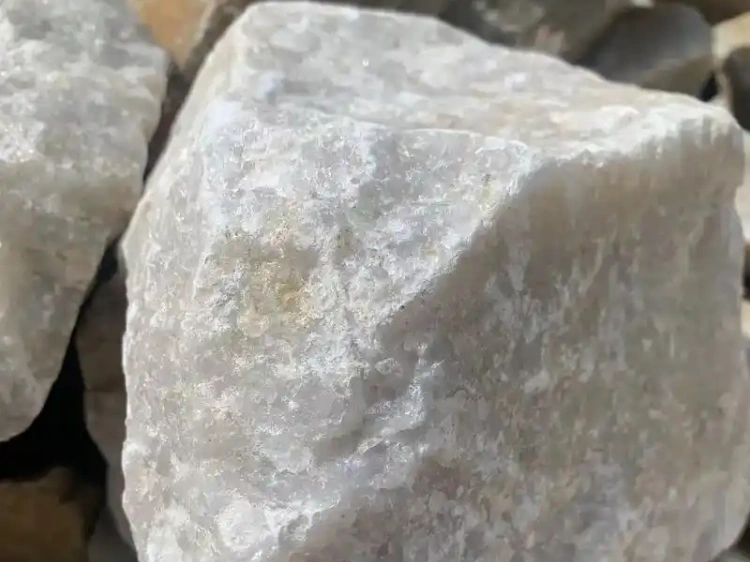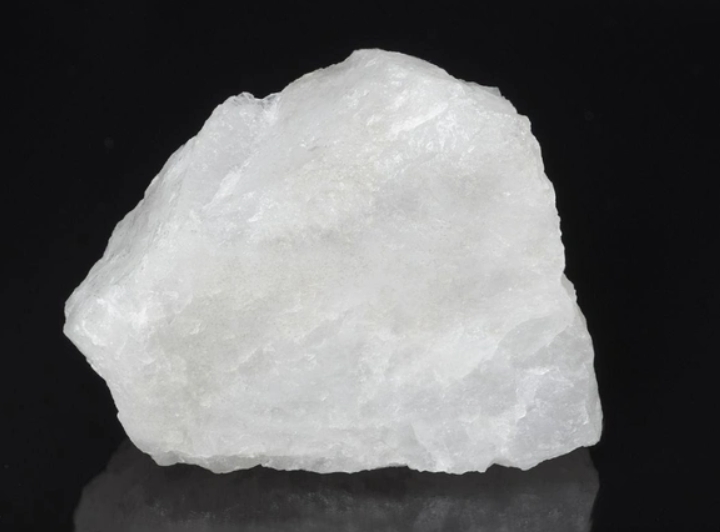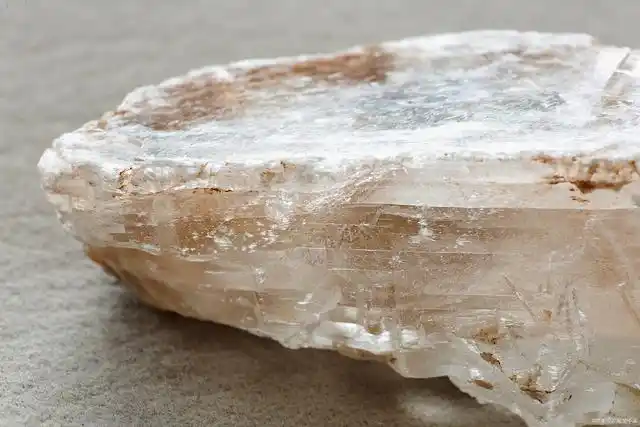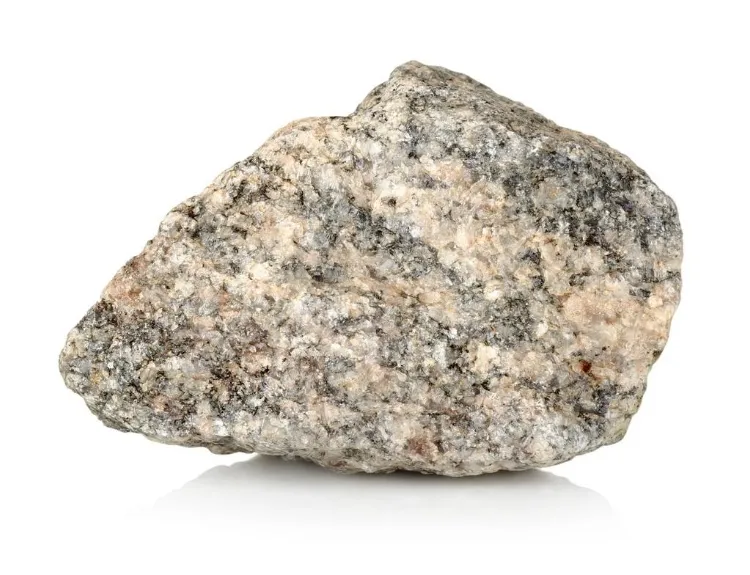ควอตซ์ is a widely distributed แร่ in the Earth’s crust. Its เคมี composition is silicon dioxide (SiO₂). Due to its unique physical and chemical properties, such as high hardness and high temperature resistance, and strong chemical stability, quartz is essential in glassmaking, electronics, ceramics, construction, and optics. These diverse applications drive the need to understand quartzs sources deeply. Quartzs sources are mainly classified into the following seven major types.
Natural crystal
Natural crystal is a colorless, transparent crystalline form of quartzs, primarily composed of silicon dioxide (SiO₂). It is one of the purest forms of quartzs found in nature, often prized for its clarity and perfection. Crystals typically grow in specific geological environments such as caves, rock fractures, joints, or fault zones, where conditions are favorable for their development.
The formation of natural crystal is a delicate and demanding process that requires the simultaneous fulfillment of four critical conditions.
- First, there must be ample growth space, allowing the crystals to expand freely without physical restrictions.
- Second, the environment must supply hydrothermal fluids rich in dissolved silica, serving as the essential building material for crystal growth.
- Third, stable and appropriate temperature and pressure conditions must be maintained to support the orderly arrangement of silica molecules into a crystalline structure.
- Finally, a sufficient amount of geological time is essential, as crystal growth is an extremely slow process, often taking thousands to millions of years to achieve significant size and clarity.
Due to these stringent requirements, large, high-quality natural crystals are relatively rare and highly valued for both industrial applications and ornamental purposes.

ควอตซ์ sandstone
Quartz sandstone, as a typical consolidated sandy rock, holds an important place among sedimentary rocks. Its primary composition is very distinct, with quartzs and siliceous clast content usually above 95%. These quartzs grains, over long periods, gather and deposit through transport by water and wind. During sedimentation, quartzs and siliceous clasts with uniform grain size and high stability are retained. Its accessory minerals are also diverse, with feldspar being a common example. Feldspar appears irregularly distributed within quartz sandstone, adding mineralogical variety to the rock. Additionally, clay minerals like kaolinite, illite, and montmorillonite are also present. Kaolinite often forms as fine, flaky aggregates.
Illite exhibits a thin, sheet-like structure. Montmorillonite has significant swelling properties when in contact with water. These clay minerals usually fill the pores between quartzs and siliceous clasts. Their presence affects the microstructure and alters the rock’s physical and chemical properties.

Vein ควอตซ์
Vein quartz mainly forms from silica-rich magmatic or metamorphic hydrothermal fluids filling fractures. Typically, raw vein quartz has a high SiO₂ grade, reaching over 98%. It contains low levels of impurities like iron (Fe). The mineral composition of vein quartz is simple and straightforward. Vein quartzs ores are highly processable and easy to purify. Some purified vein quartzs can meet the requirements for high-purity quartzs materials. However, vein quartz has high hardness and relatively small deposit sizes. Therefore, vein quartz is mostly used to produce high-end glass, silica powder, industrial silicon, and high-purity quartzs.

Quartzite
It is a metamorphic rock formed from quartz sandstone or other siliceous rocks through regional metamorphism or thermal contact metamorphism. In addition to feldspar, mica, and clay minerals, its associated minerals often include trace amounts of tourmaline, hematite, and zircon. Compared to quartz sandstone, its ore is denser, harder, and has a higher hardness.

Powdered quartz
Powdered quartz is a natural powdered form of quartzs with extremely fine particles.
Its silicon dioxide (SiO₂) content is typically very high, often exceeding 98%. Due to its fine particles, powdered quartz is widely used in industries requiring high-purity silica. It has important applications in glass, ceramics, casting, electronics, and chemicals. Additionally, powdered quartz is used in manufacturing high-end refractory materials due to its chemical stability and high-temperature resistance.

Natural quartz sand
Natural quartz sand is a sandy quartzs mineral raw material, with quartzs as its main mineral component. It forms through the long-term weathering of parent rocks like granite, quartzite, quartz sandstone, and vein quartz. Over time, quartzs grains are gradually separated and deposited, ultimately forming quartzs sand. Natural quartz sand is primarily found in marine sedimentary sand deposits and river-lake sedimentary sand deposits, where the sedimentary environment is ideal for quartzs accumulation. Due to its excellent chemical stability and physical properties, natural quartz sand is widely used in glass manufacturing, building materials, casting, chemicals, and other industries.
Granite Quartz
Granite quartz is mainly formed from silica-rich granitic magma during the late stages of magmatic evolution. As the magma cools, it forms minerals rich in silicon dioxide, such as quartzs, feldspar, and mica. As cooling continues, the quartzs crystals in granite gradually grow, forming a structure with highly pure quartzs minerals. Although pegmatite quartz is known for its high purity, the mining, crushing, and processing costs are much higher than those of other silica raw materials. Therefore, the current method primarily involves using quartzs minerals from pegmatites formed under specific geological conditions to produce high-purity quartzs. These minerals meet the chemical purity and physical performance requirements for high-end industries. As the most important source of high-purity quartzs globally, pegmatite quartz is widely used in electronics, optics, semiconductors, solar energy, and other high-tech fields.

บทสรุป
In conclusion, understanding the seven primary source types of quartz is essential for recognizing its diverse applications across various industries. From natural crystal formations to the high-purity quartzs found in pegmatites, each source type offers unique properties that cater to specific industrial needs. Whether it’s the hardness and stability of quartzs sandstone or the specialized use of vein quartzs in high-end technologies, each source plays a vital role in the production of materials ranging from everyday glass to advanced electronics. As the demand for high-quality silica continues to grow, understanding these sources will help guide future innovations in material science and industrial applications.
ผงวิเศษ
ผงมหากาพย์ประสบการณ์การทำงานในอุตสาหกรรมผงละเอียดมากว่า 20 ปี ส่งเสริมการพัฒนาผงละเอียดมากในอนาคตอย่างแข็งขัน โดยเน้นที่กระบวนการบด การบด การจำแนก และการปรับเปลี่ยนผงละเอียดมาก ติดต่อเราเพื่อขอคำปรึกษาฟรีและโซลูชันที่ปรับแต่งได้! ทีมผู้เชี่ยวชาญของเราทุ่มเทเพื่อจัดหาผลิตภัณฑ์และบริการคุณภาพสูงเพื่อเพิ่มมูลค่าให้กับการแปรรูปผงของคุณ Epic Powder—ผู้เชี่ยวชาญด้านการแปรรูปผงที่คุณวางใจได้!
